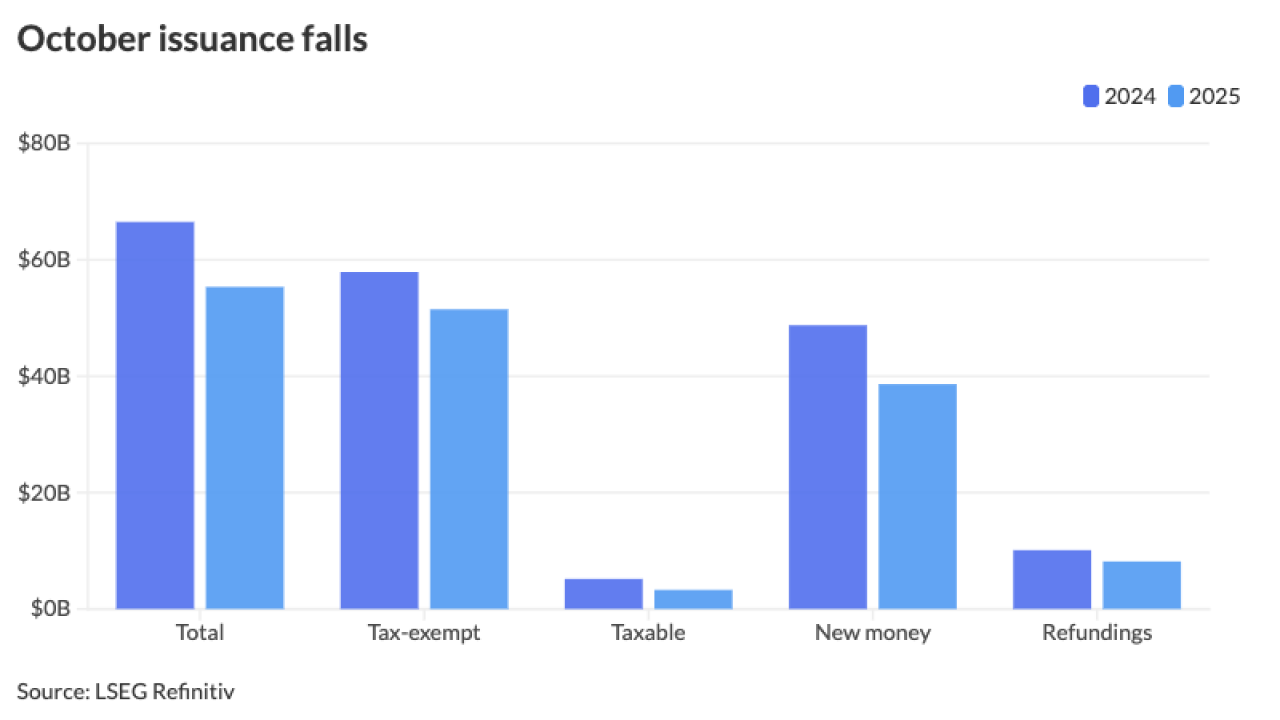
Flows into and out of municipal bond funds have been volatile this year, with a recent streak of redemptions spurring some analysts to conclude that financial woes in Puerto Rico and Chicago have scared off investors. Others have said mediocre market performance has been to blame.
The latest analyst reports, issued after a two-and-a-half month string of outflows as reported by Lipper FMI came to an end, say the impact of credit concerns on investor behavior may have been overstated, and that fund flows affect only a corner of the overall municipal bond market.
"Municipal bond funds had reported outflows for 11 straight weeks before modest inflows this [past] week and media reports have pointed to credit concerns regarding issuers such as Puerto Rico and Chicago as the reason for this development," Vikram Rai, CFA at Citi Research, writes in a new report, who argued the fund outflows were not related just to Puerto Rico.
"As we have stated on numerous occasions, rates moves are the primary drivers of fund flows and while in a rally funds experience inflows, in a sell-off they experience outflows," Rai wrote. "The same pattern is seemingly at play now, and the recent cheapening in rates caused fund flows to turn negative, though we witnessed inflows [last] week as rates dropped back down to the levels seen in early May 2015."
High-yield muni funds were another matter, Rai said.
"That being said, municipal high-yield funds have lost about 2.6% of their overall assets under management since early May 2015, while long-term funds (where outflows are typically more sensitive to rate moves) have lost only about 1% of their overall AUM over the same period," he wrote. "Thus, credit concerns seem to have become a factor for the recent spate of outflows."
Rai concludes that "municipal mutual funds, based on updated data, hold about $10 billion to $13 billion of Puerto Rico paper in terms of market value (approximately $18 billion to $22 billion in terms of notional value). Given that most of this paper is likely to be held by high-yield municipal mutual funds (which have about $69 billion in overall AUM), a spike in outflows due to credit concerns does have the potential to cause large scale dislocations."
Natalie Cohen, Senior Analyst at Wells Fargo Securities, took a look at the bigger picture of where mutual funds fit into the marketplace, saying it can be misleading to believe that fund flows are a measure of strength.
"Municipal market watchers typically hear weekly reports about funds flow in and funds flow out. When funds flow out, the media acts as if money is leaving the municipal market," Cohen writes. "But as we know, there are two sides to every trade and longer-dated mutual funds make up only about 18% of the total $3.7 trillion outstanding municipal bond market."
Cohen used the Federal Reserve's June Flow of Funds Z1 report and pre-recession holdings data to look at who owns municipal bonds and in what sectors and also to find meaningful shifts among them.
"For one thing, money market mutual funds have declined by nearly a third since 2006, not a surprise given negligible short-term rates," she wrote. "Longer-dated mutual funds have nearly doubled over this period. Municipal exchange-traded-funds too, which were virtually non-existent in 2006, have nearly doubled their holdings since 2011, although they are still a relatively small slice of the overall market."
Cohen also noted that life insurance companies have tripled their holdings since 2006; depository banks have increased their holdings by almost 145% since 2006; and that international buyers have increased their holdings by 144% over the period. On the flip side, she found that holders of broker/dealers declined nearly 60% over the period and holdings by government sponsored entities also substantially declined.
Additionally, Cohen wanted to find what the individual holders of municipal bonds were doing. She said, however, the Fed report includes non-profit organizations and hedge funds in its "Household" category of individuals.
"We suspect that the holdings of non-profits are negligible, but those of hedge funds and other alternative investors are not negligible relative to other categories," she wrote. "The best we could come up with was a Bond Buyer discussion from Nov. 13, 2013, that mentioned $166 billion. That figure included data for 116 hedge funds in North America. Other fixed-income could be mixed into that number. On the other hand, certain large debt-focused hedge funds were excluded from the count. These investments have likely grown since 2013, given the various distressed issuers (notably Puerto Rico) in the market."
So what have the "real" holders of municipal bonds been doing?
"So let's say hedge funds (and a small smatter of nonprofit institutional holdings) represent $200 billion of the $1.55 trillion 'Household' sector. Let's also assume these investors were minor participants in 2011. This would mean that the 'true' individual retail investor (i.e. in contrast to individuals who invest in mutual funds) has reduced holdings about 25% since 2011. Such a reduction in retail holdings makes sense given the 2013 'taper tantrum,' the Detroit bankruptcy filing and the awareness of Puerto Rico's severe fiscal problems since that time," Cohen concluded.





